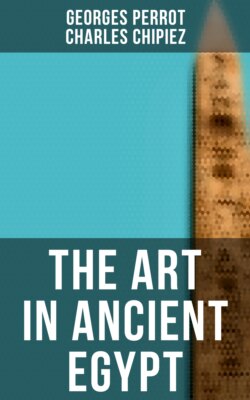Читать книгу The Art in Ancient Egypt - Perrot Georges - Страница 27
На сайте Литреса книга снята с продажи.
§ 1. Method to be Employed by us in our Study of this Architecture.
ОглавлениеTable of Contents
In the enterprise which we have undertaken the study of oriental art is but an introduction to that of Greece. Without an attentive examination of its remains we should be unable to distinguish the original elements in the work of the Greek genius from those which it borrowed from other nations. We must pass in review the whole artistic production of several great nations who occupied a vast surface of the globe, and whose fertility was prolonged through a long course of centuries, but we shall not attempt to describe singly the great buildings of Egypt and Assyria, of Persia and Phœnicia, as such an attempt would perhaps cause us to lose sight of the main object of our work.
Our task is no easy one. While limiting our study in the fashion which has been described, we must not fail to extend our purview to every fact which may help to justify the comparison which we propose to institute between the arts of Greece and those of the nations by whose teachings she profited. There is but one road to success in this double task. We must devote the greatest possible care to our study of the details in question, and then give the general results of that study; we must make ourselves thoroughly acquainted with all the phenomena, but must confine our exposition to the general laws which governed them, such as our minute inquiries have presented them to us. No circumstantial description need, therefore, be looked for in these pages even in the case of the most important and famous buildings of Egypt. No monograph upon any tomb or temple will be found, but we shall ourselves have examined many tombs and temples; we shall, to speak figuratively, have taken them to pieces, and by means of the knowledge acquired we shall endeavour to make our readers acquainted with the notions of the Egyptians upon sepulchral and religious architecture, and with the changes which those conceptions underwent in the course of centuries.
Thus, for example, we have explored the pages of Lepsius[90] and Prisse d'Avennes[91] for information relating to the sepulchres of the first six dynasties, and further researches have been made on the spot expressly for the present work, but we shall not give any descriptions or illustrations of those works individually; we shall merely use them for an ideal restoration of the characteristic tombhouse of the ancient empire. We may, perhaps, for this purpose, make a more particular reference to one or two sepulchres which are in unusually good preservation, but only for the sake of giving firm definition to the type and to its main variations.
By this analytical method of treatment we shall be enabled to give an account, which shall be at once accurate and not too long, of the constructive processes employed by the Egyptians, of the general aspect of their buildings, and of the modifications enforced by the decorative forms of which they made use. We shall be enabled to see how far those forms were decided by natural conditions, by ancient tradition, or by special wants. We shall thus include in a single chapter all that relates to principal or accessory openings, to doors and their construction, to those loftily placed windows which were calculated to give so little light. In another chapter we shall discuss the column and its capital; we shall describe the variations produced by time and materials upon its proportions and its entasis. Each assertion will be justified by reference to characteristic examples. In this matter our only difficulty will be an embarras de richesse, a difficulty of choice among the vast number of remains still existing of ancient Egypt from the time of Menes to that of the Persian conquest.
In order to avoid repetition and to put before the reader ideas which he will have no difficulty in assimilating, we shall push our work of analysis and generalization farther still. Before we embark upon the study of any special class of buildings we shall endeavour to define the general and unchanging characteristics of Egyptian architecture as a whole; characteristics which were fixed by the idiosyncracy of the race, by its beliefs and social customs, by the nature of the climate, and of the materials of which the architect could dispose. We shall do the same for Assyria and Chaldæa, for Persia and Phœnicia, for each, indeed, of the nationalities which are to be considered in our history.
These theoretical chapters will be illustrated in the same fashion as the others, except that the illustrations will partake of the generalized and abstract character of the text which they accompany. In most cases they will be simple diagrams composed for the express purpose of illustrating the definitions or descriptions to which they belong. They will each refer to some essential element in the national architecture, to some element which is not peculiar to any one edifice more than another, but is to be found in all those which have similar aims and are constructed of the same materials. Such elements are above and outside such accidental variations as may be found in details of plan or ornament; they form part of the substantial inner constitution of the arts of Egypt and Chaldæa, and make their originality indisputable.
